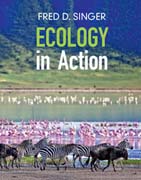
Taking a fresh approach to integrating key concepts and research processes, this undergraduate textbook encourages students to develop an understanding of how ecologists raise and answer real-world questions. Four unique chapters describe the development and evolution of different research programs in each of ecology's core areas, showing students that research is undertaken by real people who are profoundly influenced by their social and political environments. Beginning with a case study to capture student interest, each chapter emphasizes the linkage between observations, ideas, questions, hypotheses, predictions, results, and conclusions. Discussion questions, integrated within the text, encourage active participation, and a range of end-of-chapter questions reinforce knowledge and encourage application of analytical and critical thinking skills to real ecological questions. Students are asked to analyze and interpret real data, with support from online tutorials demonstrating the R programming language for statistical analysis. INDICE: Preface; Acknowledgements; Part I. Introduction and the Physical Environment: 1. What is ecology in action?; 2. The physical environment; Part II. Evolutionary and Organismal Ecology: 3. Evolution and adaptation; 4. Physiological and evolutionary ecology of acquiring nutrients and energy; 5. Physiological and evolutionary ecology of temperature and water relations; 6. Behavioral ecology; 7. Bernd Heinrich - studying adaptation in the field and the laboratory; Part III. Population Ecology: 8. Life history evolution; 9. Distribution and dispersal; 10. Population abundance and growth; 11. Conservation ecology; 12. The chimpanzees of Gombe; Part IV. Community Ecology: 13. Interspecific competition; 14. Predation and other exploitative interactions; 15. Facilitation; 16. Complex interactions and food webs; 17. Biological diversity and community stability; 18. Dan Janzen and Winnie Hallwachs - community interactions and tropical restoration through biodiversity conservation; Part V. Ecosystem and Global Ecology: 19. Ecosystem structure and energy flow; 20. Nutrient cycles: global, regional and local; 21. Disturbance and succession; 22. Geographic and landscape ecology; 23. The carbon cycle and climate change ecology; 24. Jane Lubchenco - from the marine intertidal to global service; 25. Epilogue; Glossary; References; Figure and quotation credits; Index.
- ISBN: 978-1-107-11537-8
- Editorial: Cambridge University Press
- Encuadernacion: Cartoné
- Páginas: 719
- Fecha Publicación: 10/03/2016
- Nº Volúmenes: 1
- Idioma: Inglés
